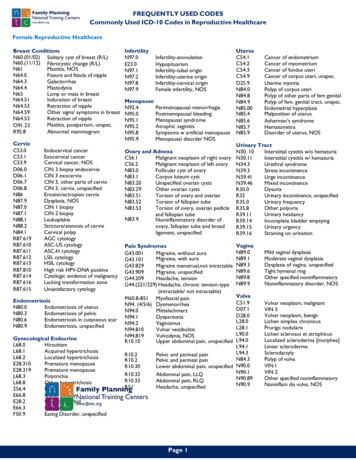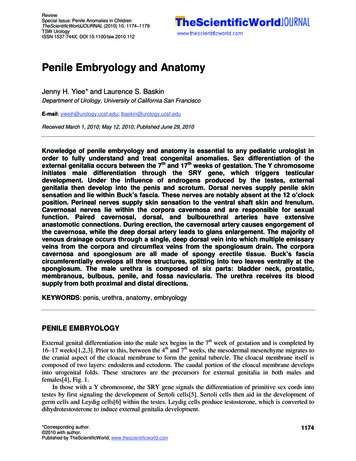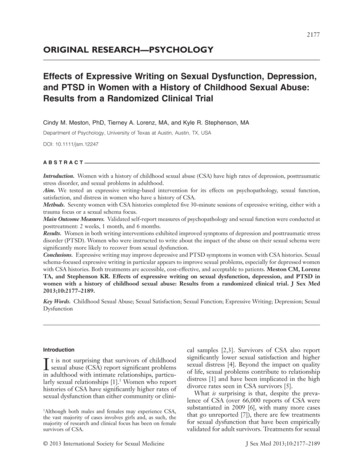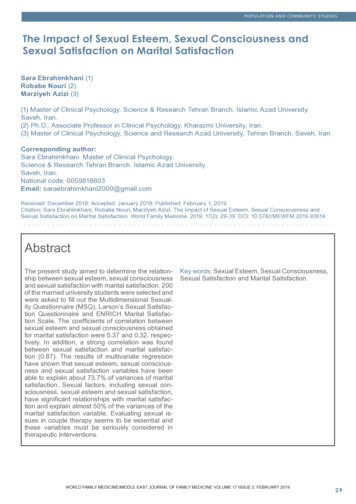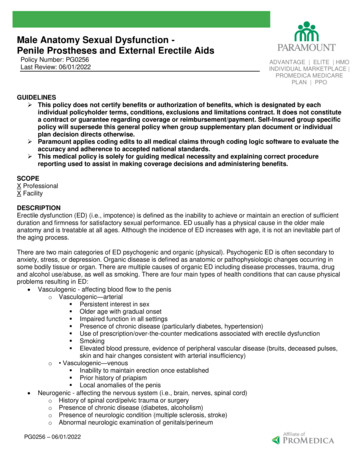
Transcription
Male Anatomy Sexual Dysfunction Penile Prostheses and External Erectile AidsPolicy Number: PG0256Last Review: 06/01/2022ADVANTAGE ELITE HMOINDIVIDUAL MARKETPLACE PROMEDICA MEDICAREPLAN PPOGUIDELINES This policy does not certify benefits or authorization of benefits, which is designated by eachindividual policyholder terms, conditions, exclusions and limitations contract. It does not constitutea contract or guarantee regarding coverage or reimbursement/payment. Self-Insured group specificpolicy will supersede this general policy when group supplementary plan document or individualplan decision directs otherwise. Paramount applies coding edits to all medical claims through coding logic software to evaluate theaccuracy and adherence to accepted national standards. This medical policy is solely for guiding medical necessity and explaining correct procedurereporting used to assist in making coverage decisions and administering benefits.SCOPEX ProfessionalX FacilityDESCRIPTIONErectile dysfunction (ED) (i.e., impotence) is defined as the inability to achieve or maintain an erection of sufficientduration and firmness for satisfactory sexual performance. ED usually has a physical cause in the older maleanatomy and is treatable at all ages. Although the incidence of ED increases with age, it is not an inevitable part ofthe aging process.There are two main categories of ED psychogenic and organic (physical). Psychogenic ED is often secondary toanxiety, stress, or depression. Organic disease is defined as anatomic or pathophysiologic changes occurring insome bodily tissue or organ. There are multiple causes of organic ED including disease processes, trauma, drugand alcohol use/abuse, as well as smoking. There are four main types of health conditions that can cause physicalproblems resulting in ED: Vasculogenic - affecting blood flow to the peniso Vasculogenic—arterial Persistent interest in sex Older age with gradual onset Impaired function in all settings Presence of chronic disease (particularly diabetes, hypertension) Use of prescription/over-the-counter medications associated with erectile dysfunction Smoking Elevated blood pressure, evidence of peripheral vascular disease (bruits, deceased pulses,skin and hair changes consistent with arterial insufficiency)o Vasculogenic—venous Inability to maintain erection once established Prior history of priapism Local anomalies of the penis Neurogenic - affecting the nervous system (i.e., brain, nerves, spinal cord)o History of spinal cord/pelvic trauma or surgeryo Presence of chronic disease (diabetes, alcoholism)o Presence of neurologic condition (multiple sclerosis, stroke)o Abnormal neurologic examination of genitals/perineumPG0256 – 06/01/2022
Hormonal –affecting the levels of certain hormones (e.g., testosterone)o Loss of interest in sexual activityo Small atrophic testiso Low testosterone, elevated prolactinAnatomical –affecting the physical structure of the peniso Peyronie’s diseaseFirst-and second-line therapies include oral, self-injectable or transdermal medications as well as external penilepumps. Surgical implantation of a penile prosthesis is also a treatment option for ED, particularly among men whocannot use or who have not responded to first-and second-line therapies.Penile implants are prosthetic devices surgically inserted into the corpus cavernosum. Two types of penile implantsare available: inflatable and semi rigid (noninflatable): Inflatable penile prostheses are designed to approximate the rigidity and flaccidity of the normallyfunctioning penis and are available as two-piece or three-piece components. Inflation occurs by manuallysqueezing a pump. Semi-rigid (noninflatable) penile implants are made of firm yet malleable material so that the resultingpermanent erection can be manually positioned downward close to the body unnoticeably.Complications of penile implants may include erosion, impaired sensation, infection, mechanical failure, penileshortening and urethral injury.Vacuum erection devices (VEDs) offer a mechanical nonsurgical method of filling the penis with blood and creatingan erection. VEDs are usually comprised of an airtight tube, a handheld or battery operated pump and a ring. Air isremoved from the cylinder by the pump, thereby creating a vacuum and drawing blood into the penis. The erectionis maintained by trapping the blood in the penis with a tight elastic band around its base.This policy does not address dysphoria and gender reassignment surgery.POLICYHMO, PPO, Individual Marketplace, Elite/ProMedica Medicare Plan, AdvantageSurgical implantation of a penile prosthesis (54400, 54401, 54405, C1813, C2622) does not requireprior authorization.Removal of a penile prosthesis (54406, 54408, 54410, 54411, 54415, 54416, and 54417) does notrequire prior authorization.Penile vacuum constriction devices (L7900, L7902) do not require prior authorization for HMO,PPO, Individual Marketplace, & Elite/ProMedica Medicare Plan.Penile vacuum constriction devices (L7900, L7902) are non-covered for Advantage.Penile prostheses and external erectile aids of any kind may be excluded under a member’s benefit plan, refer tothe applicable benefit plan document to determine benefit availability and the terms, conditions and limitations ofcoverage. When penile prostheses and external erectile aids is available for the treatment of the male anatomysexual dysfunction, the following conditions of coverage apply.HMO, PPO, Individual Marketplace, Elite/ProMedica Medicare Plan, AdvantageCOVERAGE CRITERIA - surgical implantation of a penile prosthesisParamount considers the surgical implantation of a penile prosthesis as medically necessary when ALL of thefollowing criteria have been met: Erectile dysfunction is due to an organic etiology that directly contributes to sexual dysfunction and is notpsychological in nature; and An appropriate evaluation must be done to determine the necessity for the surgical implantation of a penileprosthesis, including, but not limited to;PG0256 – 06/01/2022
ooo A medical, psychosocial and sexual historyPhysical examinationAppropriate laboratory and diagnostic evaluation (The laboratory testing should be thorough enoughto identify comorbid conditions that may predispose the patient to ED and that may contraindicatecertain therapies.)*o Absence of active alcohol or substance abuseo Absence of drug-induced impotence related to the inappropriate use of anabolic steroids,anticholinergics, antidepressants, antipsychotics or central nervous system depressants; Absenceof untreated depression or psychiatric illness; ando Documentation of all medicinal and nonsurgical methods that have proven ineffective or arecontraindicated (e.g., past treatments and results of treatments to include pharmacotherapy, medicaldevices, etc.); andErectile dysfunction has persisted at least six months; andThere is failure, contraindication or intolerance to pharmacological therapyo Consideration has been given to intracavernosal injection, intraurethral medication, suppositories,PDE5 inhibitors; andThere is failure of vacuum constriction devices; andErectile dysfunction of vasculogenic etiology as a result of any one or more of the following:o Documented injury to perineum/genitalia; oro Following radiation therapy for prostate cancer; oro Following pelvic trauma affecting anal and/or bladder and/or erection control; oro Following vascular surgery involving aorta or femoral blood vessels; oro Peyronie’s disease; oro Vascular insufficiency oro Venous incompetence documented by dynamic infusion cavernosometry and cavernosography(DICC); oro Venous leak of the penis; orErectile dysfunction of neurogenic etiology as a result of one or more of the following:o Following bladder, bowel, prostate or spinal surgery; oro Fractured pelvis; oro Neurological disease (eg, diabetic neuropathy, multiple sclerosis, spina bifida);o Secondary to spinal cord injury (paraplegia or quadriplegia); orFor erectile dysfunction without a definitive neurogenic or vasculogenic etiology listed above (eg, impairedrenal function), endocrine (hormonal) or other causes have been ruled out or treated, as evidenced by thefollowing:o Absence of active alcohol, anabolic steroid and substance abuse; ando Absence of psychogenic erectile dysfunction, untreated depression and untreated psychiatric illness;ando Documentation that prolactin, testosterone and thyroid levels are within normal limits; andMember is free of contraindications including but not limited to:o System infection; ando Active urogenital infections; ando Active skin infection in the region of surgery.Paramount considered the surgical removal and/or replacement of a medically necessary penile prosthetic device(as indicated above) due to malfunction of the prosthesis or patient complications, when benefit coverage isavailable.Paramount covers the removal of a penile prosthesis as medically necessary for ANY of the followingcomplications: Infection Mechanical failure Urinary obstruction Intractable painPG0256 – 06/01/2022
Paramount does not cover a penile prosthesis for ANY other indication because it is considered not medicallynecessary, including but not limited to the following: Psychogenic erectile dysfunction, which may be manifested as follows:o Inhibited sexual excitemento Inhibited orgasmo Premature ejaculationo Functional dyspareunia Alcohol or substance abuse Any untreated medical condition*Note: Please refer to the applicable pharmacy benefit plan document to determine benefit availability and theterms, conditions and limitations of coverage for the treatment of erectile dysfunction medications.HMO, PPO, Individual Marketplace, Elite/ProMedica Medicare PlanCOVERAGE CRITERIA - vacuum erection deviceVacuum erection devices (VEDs) (e.g., ErecAid) offer a mechanical nonsurgical method of filling the penis withblood and creating an erection. VEDs are usually comprised of an airtight tube, a handheld or battery operatedpump and a ring. Air is removed from the cylinder by the pump, thereby creating a vacuum and drawing blood intothe penis. The erection is maintained by trapping the blood in the penis with a tight elastic band around its base.When coverage is available for a vacuum constriction device, it may be subject to the terms, conditions andlimitations of the applicable benefit plan’s Durable Medical Equipment (DME) benefit and schedule of copayments.Although they may be prescribed by a health care practitioner, vacuum erection devices are also available withouta prescription, may be obtained over the counter (OTC), and are therefore generally excluded in the certificate. Inthe absence of a certificate exclusion for OTC items, these devices are considered not medically necessary asdefined in the member’s individual certificate. Please refer to the applicable benefit plan document to determinebenefit availability and the terms, conditions and limitations of coverage.Paramount considers a vacuum constriction device (L7900, L7902) as medically necessary for the treatment oferectile dysfunction when ALL of the following criteria are met: Member is at least 18 years of age; and Erectile dysfunction is due to an organic etiology and is not psychological in nature; and An appropriate evaluation must be done to determine the necessity for the external penile vacuum pump,including, but not limited to;o A medical, psychosocial and sexual historyo Physical examinationo Appropriate laboratory and diagnostic evaluation (The laboratory testing should be thorough enoughto identify comorbid conditions that may predispose the patient to ED and that may contraindicatecertain therapies.)*; and Member has the manual dexterity to utilize the device; and Adequate penile blood supply is present; and Contraindications are not present, including, but not limited to:o Blood dyscrasias, including sickle cell diseaseo Member is presently taking anticoagulantsParamount does not cover a vacuum constriction device for ANY other indication because it is considered notmedically necessary.AdvantagePenile vacuum constriction devices (L7900, L7902) are non-covered for Advantage.HMO, PPO, Individual Marketplace, Elite/ProMedica Medicare Plan, AdvantageLimitations:The following are not covered for treatment of ED: Nerve graft (eg, sural nerve graft)PG0256 – 06/01/2022
Venous ligation in the treatment of venous leak impotencyVascular surgery (revascularization of the corpora, CPT 37788 or penile venous occlusive procedure, CPT37790) is not covered except in a young patient without identifiable risk factors for impotency or who hassuffered perineal or pelvic trauma (higher success rates in younger men with congenital or traumaticabnormalities)Platelet-rich plasma (PRP) therapyStem cell (SC) therapyShockwave therapy, also referred to as low-intensity extracorporeal shockwave therapy (LI-ESWT)AcupunctureThe following diagnostic workup and laboratory testing for the diagnosis of erectile dysfunction is consideredmedically indicated: Duplexscan (Doppler and ultrasound) in conjunction with intracorporeal papaverine Dynamic infusion cavernosometry and cavernosography only for members who are to undergo revascularization procedures and meet medical necessity criteria for penile re-vascularization (see below) Pharmacological response test for erectile dysfunction (using vasoactive drugs, e.g., papaverine HCl,phentolamine mesylate, prostaglandin E1) Biothesiometry (Note: Biothesiometry is considered an integral part of the comprehensive history andphysical examination.) Blood glucose Complete blood count Creatinine Hepatic panel Lipid profile Prostate specific antigen Serum testosterone Tests for evaluation of pituitary dysfunction (e.g., measurement of luteinizing hormone, follicle-stimulatinghormone, and prolactin levels) if serum testosterone level is below normal Thyroid function studies Urinalysis.The following workup / laboratory tests for the diagnosis of erectile dysfunction is considered experimental andinvestigational because their effectiveness has not been established: Angiotensin-converting enzyme insertion/deletion polymorphism testing (for determining erectile dysfunctionsusceptibility) Cavermap cavernous nerves electrical stimulation with penile plethysmography (also referred to ascavernosal nerve mapping). Corpora cavernosal electromyography Dorsal nerve conduction latencies Endothelial nitric oxide synthase polymorphism (4 VNTR, G894T, and T786C) testing for estimating risk oferectile dysfunction Evoked potential measurements (including stimulus evoked response for measurement of bulbocavernosusreflex latency) Iron binding capacity Measurement of serum melatonin levels Measurement of serum vitamin D levels Penile plethysmography Prostatic acid phosphatase Shear wave elastography The use of serum biomarkers (e.g., E-selectin, endothelial progenitor cells, endothelial micro-particles,homocysteine, interleukin-10, malondialdehyde, nitric oxide, and ratio of tumor necrosis factor-alpha to IL10) for the development and/or progression of EDPG0256 – 06/01/2022
CODING/BILLING INFORMATIONThe inclusion or exclusion of a code in this section does not necessarily indicate coverage. Codes referenced inthis clinical policy are for informational purposes only.Codes that are covered may have selection criteria that must be met.Payment for supplies may be included in payment for other services rendered.CPT CODES54400 Insertion of penile prosthesis non-inflatable (semi-rigid)54401 Insertion of penile prosthesis inflatable (self-contained)Insertion of multicomponent inflatable penile prosthesis including placement of pump, cylinders and54405reservoirRemoval of all components of a multi-component, inflatable penile prosthesis without replacement of54406prosthesis54408 Repair of component(s) of a multi-component, inflatable penile prosthesisRemoval and replacement of all component(s) of a multi-component, inflatable penile prosthesis at54410the same operative sessionRemoval and replacement of all components of a multi-component inflatable penile prosthesis54411 through an infected field at the same operative session, including irrigation and debridement ofinfected tissueRemoval of non-inflatable (semi-rigid) or inflatable (self-contained) penile prosthesis, without54415replacement of prosthesisRemoval and replacement of non-inflatable (semi-rigid) or inflatable (self-contained) penile54416prosthesis at the same operative sessionRemoval and replacement of non-inflatable (semi-rigid) or inflatable (self-contained) penile54417 prosthesis through an infected field at the same operative session, including irrigation anddebridement of infected tissueHCPCS CODESC1813C2622L7900L7902Prosthesis, penile, inflatableProsthesis, penile, non-inflatableMale vacuum erection systemTension ring, for vacuum erection device, any type, replacement only, eachParamount reserves the right to review and revise our policies periodically when necessary. Whenthere is an update, we will publish the most current policy viders/medical-policies/ .REVISION HISTORY EXPLANATIONORIGINAL EFFECTIVE DATE: 08/01/2009DateExplanation & Changes Title changed from Penile Implant Surgical Services and Prosthesis to Male SexualDysfunction Treatment: Non-pharmacologic Added codes 54406, 54408, 54415, & L790209/08/15 Removed code L8699 Policy reviewed and updated to reflect most current clinical evidence per Medical PolicySteering Committee Gender verbiage changes completed per Meaningful Access Section 1557 of the Affordable11/23/16Care Act12/18/2020 Medical policy placed on the new Paramount Medical Policy Format Title changed from Male Anatomy Sexual Dysfunction Treatment: Non-pharmacologic to06/13/2022Male Anatomy Sexual Dysfunction - Penile Prostheses and External Erectile Aids Policy reviewed and updated to reflect most current clinical evidencePG0256 – 06/01/2022
REFERENCES/RESOURCESCenters for Medicare and Medicaid Services, CMS Manual System and other CMS publications andservicesOhio Department of MedicaidAmerican Medical Association, Current Procedural Terminology (CPT ) and associated publications andservicesCenters for Medicare and Medicaid Services, Healthcare Common Procedure Coding System, HCPCSRelease and Code SetsU.S. Preventive Services Task Force, try Standard ReviewHayes, Inc.Industry Standard ReviewPG0256 – 06/01/2022
an erection. VEDs are usually comprised of an airtight tube, a handheld or battery operated pump and a ring. Air is removed from the cylinder by the pump, thereby creating a vacuum and drawing blood into the penis. The erection is maintained by trapping the blood in the penis with a tight elastic band around its base.


